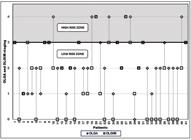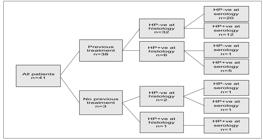ABSTRACT
BACKGROUND:
H. pylori chronic atrophic gastritis is a premalignant lesion, and its staging, according to OLGA and OLGIM systems aims to identify patients at increased risk of developing gastric cancer and optimize their follow-up. GastroPanel®, serum biomarkers panel including pepsinogen I (PGI), pepsinogen II (PGII), Gastrin 17 (G17) and anti- H. pylori antibodies is a noninvasive test for adenocarcinoma risk assessment in chronic H. pylori gastritis patients.
OBJECTIVE:
Prospective study to evaluate the concordance between OLGA and OLGIM grading systems, as well as to evaluate GastroPanel´s performance in patients with premalignant lesions secondary to H. pylori chronic gastritis in Brazil.
METHODS:
Patients with H. pylori chronic gastritis with premalignant lesions confirmed by histology were recruited from the gastrointestinal clinic of a University Hospital. All participants underwent endoscopic examination with biopsies which were reported according to updated Sydney system and premalignant lesions grading systems (OLGA and OLGIM). Blood samples were collected for biomarkers serological analysis (GastroPanel®, Biohit, Helsinki, Finland). The cut off values used to define high risk patients were those recommended by the manufacturer: PGI ≤30 µm/L and PGI/PGII ≤3.
RESULTS:
41 patients were recruited: 28 women, 13 men, mean age 67.3 (47-89, SD: 9.6) years. By OLGA system, were obtained: OLGA 0 (n=1), OLGA I (n=7), OLGA II (n=17), OLGA III (n=9), and OLGA IV (n=7). By OLGIM system, were obtained: OLGIM 0 (n=14), OLGIM I (n=5), OLGIM II (n=10), OLGIM III (n=10), and OLGIM IV (n=2). Regarding histological staging among patients staged as low risk (OLGA/OLGIM 0, I and II) and high risk (OLGA/OLGIM III and IV) for gastric cancer development, the concordance rate found between both classifications was 85.4%. Considering high risk patients, those patients thus included in at least one of the systems the final distribution of our sample considered 24 low-risk and 17 high-risk patients for the development of gastric cancer. To determine by GastroPanel® whether the patient would be at low or high risk of developing gastric cancer, PGI showed a sensitivity, specificity and accuracy of 0.47 (95%CI: 0.26-0.69), 0.67 (95%CI: 0.47-0.82), and 0.58 (95%CI: 0.43-0.72), respectively, while PGI/PGII showed sensitivity, specificity and accuracy of 0.06 (95%CI: 0.01-0.27), 0.83 (95%CI: 0.64-0.93) and 0.51 (95%CI: 0.36-0.66), respectively.
CONCLUSION:
The histological classifications OLGA and OLGIM presented a substantial concordance rate among themselves. Simultaneous use of both histological classification systems increased the identification’s rate of high-risk patients. Biomarker analysis was not effective to distinguish low to high risk patients in the studied population. Further studies are needed to validate its use in clinical practice in Brazil.
HEADINGS:
Atrophic gastritis, diagnosis; Helicobacter pylori; Severity of illness index; Biomarkers; Algorithms

 Thumbnail
Thumbnail
 Thumbnail
Thumbnail

